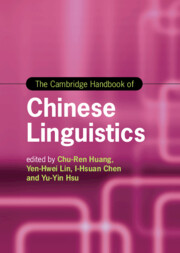Book contents
- The Cambridge Handbook of Chinese Linguistics
- Cambridge Handbooks In Language and Linguistics
- The Cambridge Handbook of Chinese Linguistics
- Copyright page
- Contents
- Figures
- Tables
- Contributors
- Acknowledgments
- Part One Writing System/Neuro-cognitive Processing of Chinese
- Part Two Morpho-lexical Issues in Chinese
- 3 Wordhood and Disyllabicity in Chinese
- 4 Characters as Basic Lexical Units and Monosyllabicity in Chinese
- 5 Parts of Speech in Chinese and How to Identify Them
- 6 Gaps in Parts of Speech in Chinese and Why?
- 7 Derivational and Inflectional Affixes in Chinese and Their Morphosyntactic Properties
- 8 The Extreme Poverty of Affixation in Chinese
- 9 On an Integral Theory of Word Formation in Chinese and Beyond
- 10 Compounding Is Semantics-driven in Chinese
- Part Three Phonetic-phonological Issues in Chinese
- Part Four Syntax-semantics, Pragmatics, and Discourse Issues
- Index
- References
4 - Characters as Basic Lexical Units and Monosyllabicity in Chinese
from Part Two - Morpho-lexical Issues in Chinese
Published online by Cambridge University Press: 04 August 2022
- The Cambridge Handbook of Chinese Linguistics
- Cambridge Handbooks In Language and Linguistics
- The Cambridge Handbook of Chinese Linguistics
- Copyright page
- Contents
- Figures
- Tables
- Contributors
- Acknowledgments
- Part One Writing System/Neuro-cognitive Processing of Chinese
- Part Two Morpho-lexical Issues in Chinese
- 3 Wordhood and Disyllabicity in Chinese
- 4 Characters as Basic Lexical Units and Monosyllabicity in Chinese
- 5 Parts of Speech in Chinese and How to Identify Them
- 6 Gaps in Parts of Speech in Chinese and Why?
- 7 Derivational and Inflectional Affixes in Chinese and Their Morphosyntactic Properties
- 8 The Extreme Poverty of Affixation in Chinese
- 9 On an Integral Theory of Word Formation in Chinese and Beyond
- 10 Compounding Is Semantics-driven in Chinese
- Part Three Phonetic-phonological Issues in Chinese
- Part Four Syntax-semantics, Pragmatics, and Discourse Issues
- Index
- References
Summary
This chapter revisits the character-based approach to Chinese grammar and the ongoing debate about how to define the concept of a word in Chinese. The authors provide a variety of evidence, including distributional generalizations in corpus and Chinese word-level and phrase-level rules, such as Mandarin alphabetic words, replaceable idioms, and abbreviations, to argue that character and monosyllabicity plays an indispensable role in Chinese linguistics. It is shown that although words do serve as basic units in Chinese grammar, yet some important generalizations of Chinese grammar cannot be achieved without also employing the concept of characters. The examples provided in the chapter show that some morphosyntactic constraints can be better accommodated by treating characters as basic units in addition to words. In conclusion, the authors return to an integrated account of character as both an orthographic and linguistic unit in Chinese. This integrated account captures fully and more precisely Chinese syntactic and word formation behaviors that had been challenging to word-based accounts.
Keywords
- Type
- Chapter
- Information
- The Cambridge Handbook of Chinese Linguistics , pp. 74 - 96Publisher: Cambridge University PressPrint publication year: 2022



